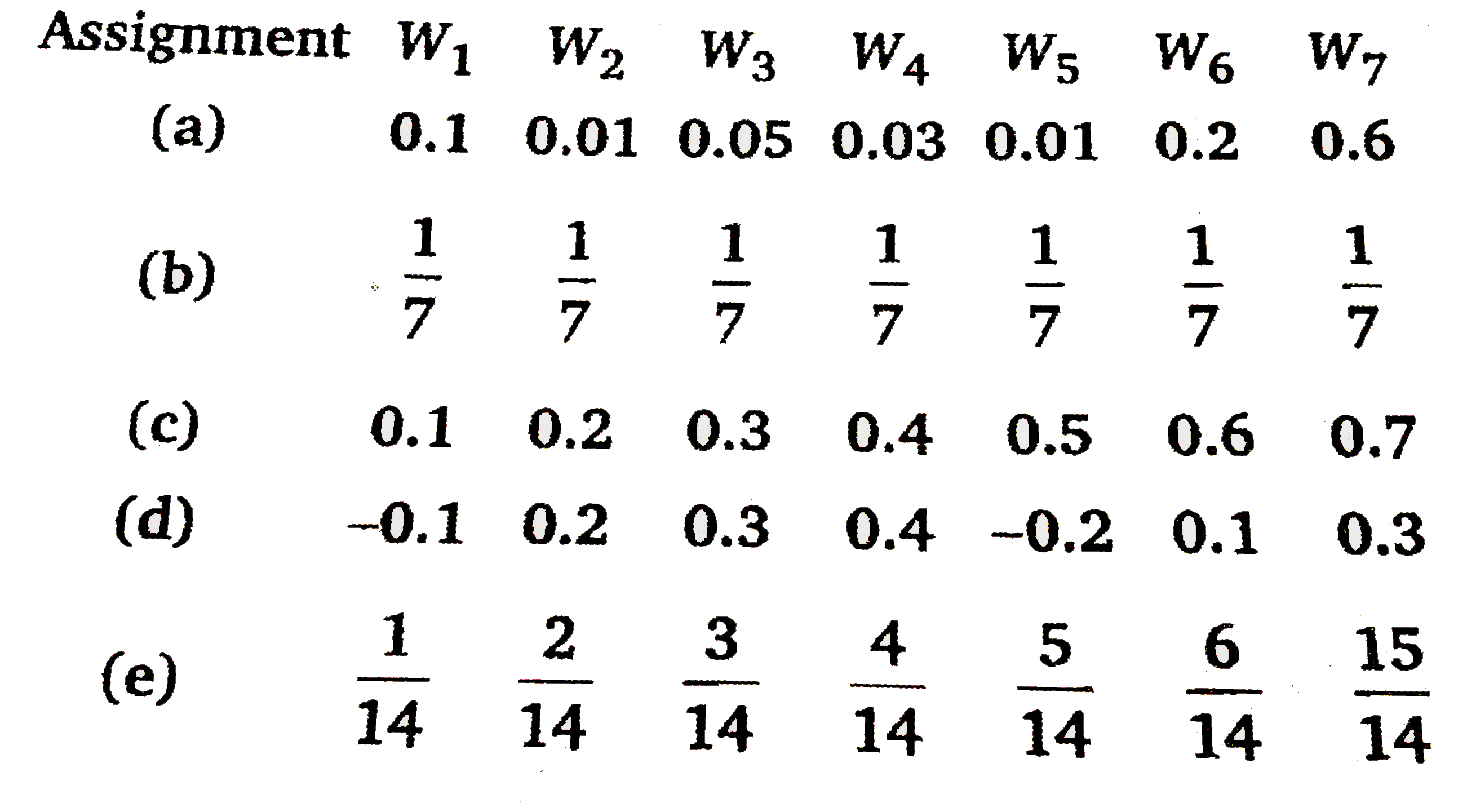A sample space consists of 9 elementary outcomes outcomes E1,E2,…, E9 whose probabilities are:
P(E_(1))=P(E_(2)) = 0.09, P(E_(3))=P(E_(4))=P(E_(5))=0.1<br>P(E_(6)) = P(E_(7)) = 0.2, P(E_(8)) = P(E_(9)) = 0.06<br>IfA = {E_(1), E_(5), E_(8)}, B= {E_(2), E_(5), E_(8), E_(9)}then<br>(a)Calca––teP(A),P(B),andP(AnnB).<br>(b)Usingtheadditionlawofprobability,calca––teP(A uu B).<br>(c)ListthecompositionoftheeventA uu B,andcalca––teP(A uu B)byadd∈gtheprobabilitiesofthee≤mentaryoutcomes.<br>(d)Calca––teP(barB)omP(B),alsocalca––teP(barB) directly from the elementarty outcomes of B. Solution in Tamil
(a) P(A)=P(E1)+P(E5)+P(E8)
=0.09+0.1+0.06=0.25
(b) P(B)=P(E2)+P(E5)+P(E8)=P(E9)
=0.09+0.1+0.06+0.06=0.31
P(A∪B)=P(A)+P(B)−P(A∩B)
Now, A∩B={E5,E8}
∴P(A∩B)=P(E5)+P(E8)=0.1+0.06=0.16
∴P(A∪B)=0.25+0.31−0.16=0.40
(c ) A∪B={E1,E2,E5,E8,E9}
P(A∪B)=P(E1)+P(E2)+P(E5)+P(E8)+P(E9)
=0.09+0.09+0.1+0.06+0.06=0.40
(d) ∵P(¯¯¯B)=1−P(B)=1−0.31=0.69
and ¯¯¯B={E1,E3,E4,E6,E7}
∴P(¯¯¯B)=P(E1)+P(E3)+P(E4)+P(E6)+P(E7)
= 0.09 + 0.1 + 0.1 + 0.2 + 0.2 = 0.69
Topper's Solved these Questions
- BOOK - CENGAGECHAPTER - PROBABILITY I EXERCISE - Solved Example1videos
PROBABILITY I
- BOOK - CENGAGECHAPTER - PROBABILITY I EXERCISE - Exercise 9.16videos
PROBABILITY I
- BOOK - CENGAGECHAPTER - PROBABILITY AND STATISTICSEXERCISE - Question Bank24videos
PROBABILITY AND STATISTICS
- BOOK - CENGAGECHAPTER - PROBABILITY IIEXERCISE - JEE Advanced Previous Year25videos
PROBABILITY II
Similar Questions
There are two bags each containing 10 books all having different titles but of the same size. A student draws out books from the first bag as well as from the second bag. Find the probability that the different between the books drawn from the two bags does not exceed 2.
06:27View SolutionWhich of the following cannot be valid assignment of probabilities for outcomes of sample space S={W1,W2,W3,W4,W5,W6,W7}
 02:45View Solution
02:45View SolutionIf two events A and B are such that P(Al)=0.3, P(B)=0.4 and P(A∩Bl)=0.5, then P(BA∪Bl) equals
03:12View SolutionA signal which can be green or red with probability 45and15 respectively, is received by station A and then and 3 transmitted to station B. The probability of each station receiving the signal correctly is 34 If the signal received at station B is green, then the probability that the original signal was green is (a) 35 (b) 67 (c) 2023 (d) 920
07:58View Solution= E_ (1), E_ (2), E_ (3), E_ (1), E_ (5) and P (E_ (1)) = (95) / (100), P (E_ (2) | E_ (1)) = (93) / (99), P (E_ (3) | E_ (1) E_ (2) E_ (3)) = (92) / (97) and P (E_ (5) | E_ (1) E_ (2) E_ (3) E_ (4)) = (91) / (96) n P (E) equals
02:15View SolutionIf E_(1) and E_(2) are events of a sample space such that P(E_(1))=(1)/(4),P((E_(2))/(E_(1)))=(1)/(2),P((E_(1))/(E_(2)))=(1)/(4) Then P((E_(1))/(E_(2)))=
View Solutionif E1 and E2 are two events such that P(E1)=14,P(E2E1)=12 and P=(E1E2)=14
02:13View SolutionA sample space consists of 9 elementary outcomes E1,E2,…..,E9 whose probabilities are
P(E1)=P(E2)=0.08,P(E3)=P(E4)=P(E5)=0.1
P(E6)=P(E1)=0.2,P(E8)=P(E9)=0.07
Suppose A={E1,E5,E8},B={E2,E5,E8,E9}
(i) Calculate P(A), P(B) and P(A∩B).
(ii) Using the addition law of probability, calculate P(A∪B).
(iii) List the composition of the event A∪B and calculate P(A∪B) by adding the probabilities of the elementary outcomes.
Calculate P(−B) from P(B), also calculate P(−B) directly from the elementary outcomes of −B,02:54View SolutionIf e1,e2,e3 and e4 are the four elementary outcomes in a sample space and P(e1)=0.1,P(e2)=0.5,and P(e3)=0.1, then the probability of e4 is ……
05:39View SolutionA sample space consists of 9 elementary outcomes outcomes E1,E2,…, E9 whose probabilities are:
P(E_(1))=P(E_(2)) = 0.09, P(E_(3))=P(E_(4))=P(E_(5))=0.1<br>P(E_(6)) = P(E_(7)) = 0.2, P(E_(8)) = P(E_(9)) = 0.06<br>IfA = {E_(1), E_(5), E_(8)}, B= {E_(2), E_(5), E_(8), E_(9)}then<br>(a)Calca––teP(A),P(B),andP(AnnB).<br>(b)Usingtheadditionlawofprobability,calca––teP(A uu B).<br>(c)ListthecompositionoftheeventA uu B,andcalca––teP(A uu B)byadd∈gtheprobabilitiesofthee≤mentaryoutcomes.<br>(d)Calca––teP(barB)omP(B),alsocalca––teP(barB) directly from the elementarty outcomes of B.03:40View SolutionIf E1,E2, are independent events, such P(E1∩E2)=1/8,P(¯¯¯E1∩¯¯¯E2)=1/4, then P((E1+P(E2)=
06:32View SolutionThe two events E1,E2 are such that
P(E1∪E2)=58,P(¯¯¯E1)=34,P(E2)=12, then E1 and E2 are01:08View SolutionLet A, B,C be any three events in a sample space of a random experiment. Let the events E1= exactly one of A,B occurs, E2= exactly one of B ,c occurs, E3= exactly one of c ,A occurs, E4= all of A,B ,c occurs,E5= atleast one of A,B, c occurs P(E1)=P(E2)=P(E3)=13,P(E4)=19,P(E5)=
03:53View SolutionE1, E2 are events of a sample space such that P(E1)=14, P(E2E1)=12, P(E1E2)=14 then P(E1E2)+P(E1¯¯¯E2)=
02:06View SolutionA sample space consists of 9 elementary outcomes E1,E2,…..,E9 whose probabilities are
P(E1)=P(E2)=0.08,P(E3)=P(E4)=P(E5)=0.1
P(E6)=P(E1)=0.2,P(E8)=P(E9)=0.07
Suppose A={E1,E5,E8},B={E2,E5,E8,E9}
(i) Calculate P(A), P(B) and P(A∩B).
(ii) Using the addition law of probability, calculate P(A∪B).
(iii) List the composition of the event A∪B and calculate P(A∪B) by adding the probabilities of the elementary outcomes.
Calculate P(−B) from P(B), also calculate P(−B) directly from the elementary outcomes of −B,02:01View SolutionIf e1,e2,e3 and e4 are the four elementary outcomes in a sample space and P(e1)=0.1,P(e2)=0.5,and P(e3)=0.1, then the probability of e4 is ……
06:22View Solution
